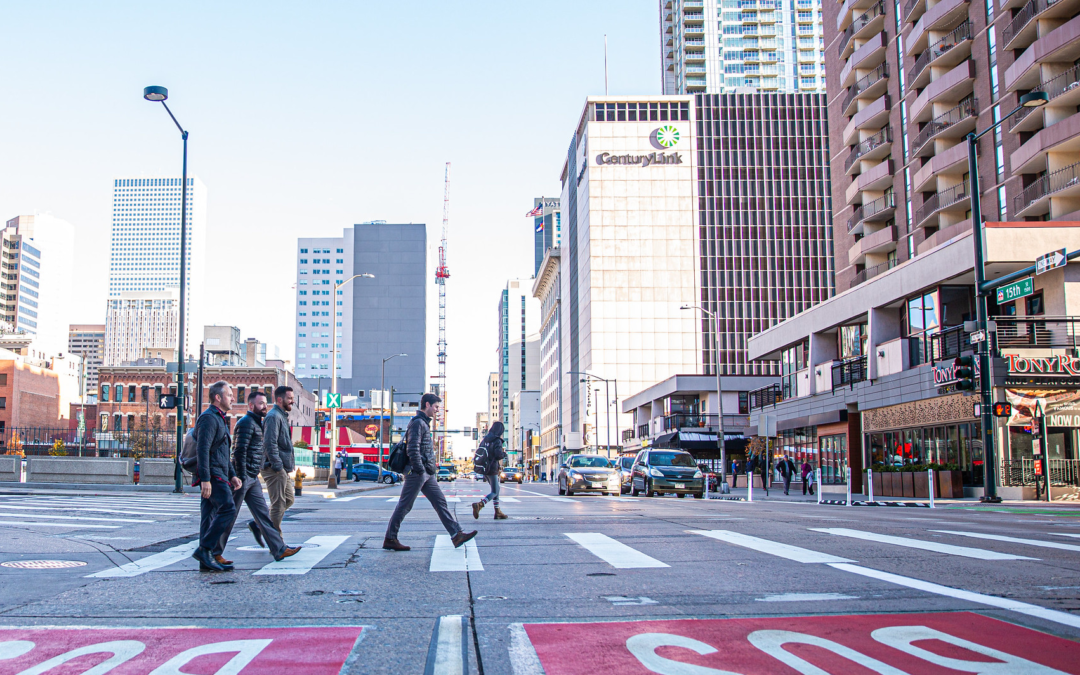 In this blog post, the DSP’s executive director, Jill Locantore, shares a perspective on sharing street space that disappeared after cars arrived on the scene in the 1920s—and needs to be brought back as more people walking, biking, rolling, and scooting move around Denver.
In this blog post, the DSP’s executive director, Jill Locantore, shares a perspective on sharing street space that disappeared after cars arrived on the scene in the 1920s—and needs to be brought back as more people walking, biking, rolling, and scooting move around Denver.
A few years ago, a friend complained to me about a person she saw biking on 13th Avenue in Denver’s Capitol Hill neighborhood, declaring that bicyclists “don’t belong” on that street. I suggested that maybe the person was trying to get to one of the great coffee shops, restaurants, or other local shops on that corridor. My friend argued that, even if that was the case, the person should have biked on a parallel street like 11th Avenue that has a bike lane, concluding that “we don’t need to allow bikes on every street.” I asked, “Do we need to allow cars on every street?” My friend looked at me like I had asked, “Do humans need oxygen to survive?”
I don’t blame my friend. The belief that our streets are first and foremost for cars, and that people walking and biking should only be accommodated to the extent that they don’t inconvenience drivers, is so deeply ingrained in our culture that it’s almost as invisible as the air we breathe. But it hasn’t always been that way.
In fact, back in the 1890s and early 1900s, it was mainly bicyclists who advocated for cities to pave their streets and expand their street networks, so that people biking would have safer, smoother places to ride. Up until the 1920s, streets were more democratic spaces shared equally by people walking, children playing, vendors selling their wares, horse-drawn vehicles, and street cars. As personal cars became more widespread, people driving cars began hitting and killing people outside of cars, leading to public outcry and calls for speed limiters on cars. The automobile industry responded by advocating for laws that restricted who had access to the street, prioritizing cars above all else. The industry also waged a mass marketing campaign that disparaged people who disobeyed these laws as “jaywalkers.”
Just because we’ve ceded our streets to cars, doesn’t mean it has to continue to be that way in the future. During the pandemic, Denver and many other cities across the U.S. transformed streets back into shared spaces almost overnight, by simply putting out some barricades and announcing that people walking and biking were not only allowed but prioritized on these streets. This proved wildly popular—the number of people walking and rolling on these streets nearly tripled—and led many residents to ask, “Can we make this permanent?”
Denver’s eBike rebate program launched in 2022 and proved to be just as popular as the Shared Streets program: 4,734 people applied for and received rebates in 2022, with about half going to low-income households. Seventy-one percent of rebate recipients said they drive their car less now that they have an eBike. Shared e-bikes and scooters (aka micromobility) also hold strong appeal among Denverites. Since the launch of Denver’s current Shared Micromobility Program in May of 2021, more than 500,000 users have taken more than 3.6 million trips on Lyft’s e-bikes and scooters, just one of the City’s two micromobility operators.
As more and more people walking, rolling, and scooting are filling Denver’s streets, particularly in the downtown area, it’s causing some people to react similarly to the automobile industry 100 years ago: calling for tighter restrictions on where bikes and scooters are allowed and more enforcement of these restrictions—including through geofencing technologies that are of questionable effectiveness—and even calling people biking and scooting by disparaging names.
But it’s not 1923 anymore, and in 2023 this kind of response is extremely counterproductive. While cars were sold to us as vehicles of freedom, by prioritizing them above all other forms of transportation we’ve developed an unhealthy dependence on driving that is causing a myriad of harms, including toxic air pollution, alarming traffic fatality rates, high household transportation costs, sprawling development patterns, excessive amounts of asphalt that contributes to urban heat island effects and stormwater management challenges, and relegation of people who don’t drive because of their age, income or a disability to the status of second class citizens. Recognizing these harms, Denver has adopted plan after plan setting goals for reducing the number of trips that people make by car, and increasing the number of trips by other modes.
So now that people are in fact walking, biking, and scooting more, what should we do? Maybe it’s time to flip the script on our streets and assert that bikes and scooters should be allowed on every street. Maybe we don’t have to allow cars on every street. We could at least start downtown, right? With the recent addition of protected bike lanes on 18th and 19th Streets, we now have dedicated space for bicyclists on most of the numbered streets—what if we did the same for the cross streets, expanding on the dedicated bike lanes already on streets like Lawrence and Arapahoe? What if we made Wynkoop in front of Union Station completely car-free? Would terrible things happen? Or would we start better aligning our streets with our adopted plans and our 21st century values, and actually make Denver a better place to live?
The Denver Streets Partnership is grateful to Lyft for sponsoring our advocacy for people-friendly streets, and for providing data cited in this blog post.

